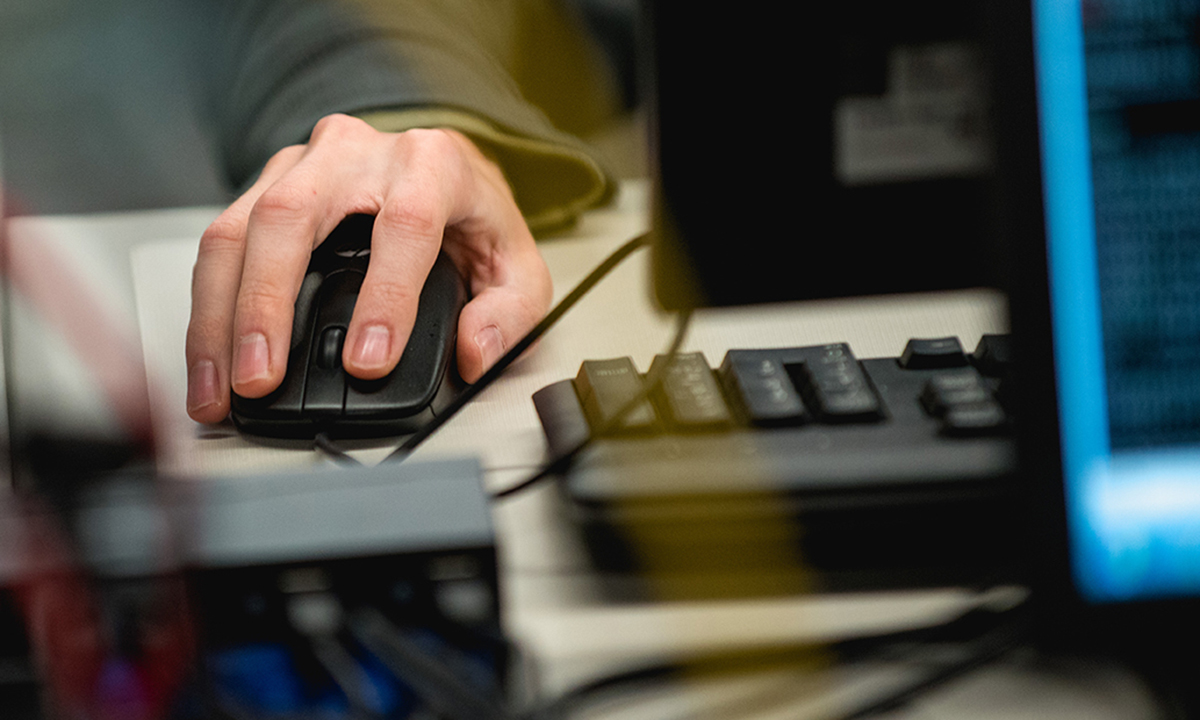New Vision
Brian Dean, Ph.D., associate professor of bioengineering and electrical and computer engineering, is at the front line of biomimetic sensor technology
Utilizing concepts from a non-engineering domain, such as biology, often incites inspiration and innovation for a variety of future technologies. Sophisticated modern engineering heavily relies on sensor technology in products, systems and manufacturing processes to provide feedback, monitoring and safety. Brian Dean, Ph.D., associate professor of bioengineering and electrical and computer engineering, is at the front line of biomimetic sensor technology – an emerging branch of sensor research that offers many advantages over its traditional counterpart.
“Developing autonomous systems, like unmanned aerial vehicles, requires hyperacuity to accurately detect powerlines and tree branches at high speeds. Yet, most camera systems are based on human vision – a single lens focuses light onto a grid of photodetectors to sample the field of view (FOV), sending information to the brain for further processing. This requires a large processing load, while the separation of photodetectors limits the motion detection capability of the sensor,” Dr. Dean says.
Biomimetic sensors are based on the compound-eye configurations found in insects. The benefits of the compound vision sensors are numerous. By using the overlapping sampling scheme between the neighboring photoreceptors, they attain motion hyperacuity that almost instantaneously extracts information about the obstacles in its FOV, including detecting very fast-moving objects or movements in an object less than a pixel size.
“Nature has developed a tremendous variety of sensors for navigation, detection and spatial orientation. Biomimetic vision sensors are inspired by various methods of vision that exist in the animal world. Compound vision sensors, mimicking the compound eye of the common housefly, possess motion hyperacuity, resulting in motion detection and tracking capabilities not matched by traditional vision sensors,” Dr. Dean says in describing his interest in biomimetic sensor technology.
Rather than capturing a frame of information to be interpreted by the fly’s brain, a lot of the signal processing happens in the intermediate neural layer, the lamina, that extracts key features of a scene and sends them to the fly’s brain to facilitate high-speed course correction and tracking. The goal of current research is to create a lamina-like processing structure for high-speed obstacle avoidance.
“In theory, the fly-inspired sensor should be able to extract the edge information from a bullet as it passes the field of view of the sensor in real-time without the need for high-speed cameras or a heavy processing load,” Dr. Dean explains.
Dr. Dean’s research, which spanned the last few years and involved numerous OU graduate and undergraduate students as well as high school teachers, has been focused on developing an improved edge detection and location algorithm for fly-inspired vision sensors (FIVS). Sakshi Agrawal, while a Ph.D. student under Dr. Dean’s supervision, was assigned as the lead student researcher on the project, managing and aiding other participants.
The original construction of the sensor and the testing were completed in the Biomimetic Sensors and Signal Processing Laboratory, followed by MATLAB simulations. The system’s design included creating circuitry input leads from seven different lenses on the artificial eye, filtering the channel signals, feeding them into a light adaptation circuit and using a signal for edge detection. With the conversion of the analog FIVS to a digital system, horizontal, vertical, forward diagonal and backward diagonal edges were simulated to pass through its FOV and their orientation and location were predicted.
As a result, the scientist and his team proposed an algorithm that can correctly classify horizontal, vertical, forward diagonal and backward diagonal edges and predict the location of the edge as it passed through the FOV of the sensor. Their future plans in this area include implementing the edge detection algorithm to demonstrate the accuracy and speed of the FIVS bioinspired processing and improving a multi-sensor system so it can simultaneously detect horizontal, vertical, diagonal edges and corners without the presence of any blind spots in its FOV.
“FIVS are cost-efficient sensors that require relatively low memory, processing power and even lighting. In addition to autonomous systems that need to detect powerlines, trees, poles, walls, pillars and other objects, they could be used in many other applications. The defense industry can utilize FIVS to identify high-speed bullets and missiles. Another interesting application could be in spotting a person, car or any other obstacle in the path of a self-driven vehicle,” shares Agrawal, Ph.D., who is currently employed as an algorithm software engineer at Bose Corporation.
In the past the work has been funded by the Air Force, National Science Foundation (NSF) Research Experience for Teachers, and Research Experience for Undergraduates. Dr. Dean is interested in additional opportunities for funding or building collaborations. Please contact him at [email protected]

 December 15, 2021
December 15, 2021
 By Arina Bokas
By Arina Bokas









